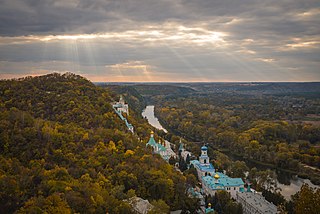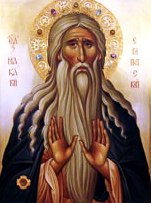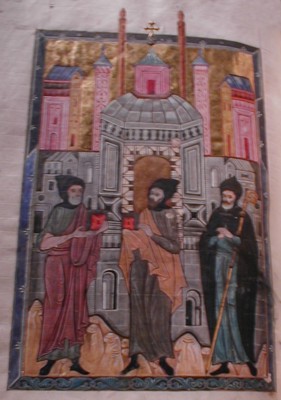
Moses the Black, also known as Moses the Strong, Moses the Abyssinian, Moses the Robber, and Moses the Ethiopian, was an ascetic monk and priest in Egypt in the fourth century AD, and a Desert Father. He is highly venerated in the Eastern Orthodox Church and the Oriental Orthodox Church. According to stories about him, he converted from a life of crime to one of asceticism. He is mentioned in Sozomen's Ecclesiastical History, written about 70 years after Moses's death.

A lavra or laura is a type of monastery consisting of a cluster of cells or caves for hermits, with a church and sometimes a refectory at the center. Lavra monasteries operate within the Orthodox and other Eastern Christian traditions; the name is also used by some Catholic communities. The term in Greek initially meant a narrow lane or an alley in a city.

Macarius of Egypt was a Christian monk and hermit. He is also known as Macarius the Elder or Macarius the Great.

Cenobiticmonasticism is a monastic tradition that stresses community life. Often in the West the community belongs to a religious order, and the life of the cenobitic monk is regulated by a religious rule, a collection of precepts. The older style of monasticism, to live as a hermit, is called eremitic. A third form of monasticism, found primarily in Eastern Christianity, is the skete.

The Desert Fathers or Desert Monks were early Christian hermits and ascetics, who lived primarily in the Scetes desert of the Roman province of Egypt, beginning around the third century AD. The Apophthegmata Patrum is a collection of the wisdom of some of the early desert monks and nuns, in print as Sayings of the Desert Fathers. The first Desert Father was Paul of Thebes, and the most well known was Anthony the Great, who moved to the desert in AD 270–271 and became known as both the father and founder of desert monasticism. By the time Anthony had died in AD 356, thousands of monks and nuns had been drawn to living in the desert following Anthony's example, leading his biographer, Athanasius of Alexandria, to write that "the desert had become a city." The Desert Fathers had a major influence on the development of Christianity.

Ammon, Amun, Ammonas, Amoun (Ἀμοῦν), or Ammonius the Hermit was a 4th-century Christian ascetic and the founder of one of the most celebrated monastic communities in Egypt. He was subsequently declared a saint. He was one of the most venerated ascetics of the Nitrian Desert, and Athanasius of Alexandria mentions him in his life of Anthony the Great.

Melania the Elder, Latin Melania Maior was a Desert Mother who was an influential figure in the Christian ascetic movement that sprang up in the generation after the Emperor Constantine made Christianity a legal religion of the Roman Empire. She was a contemporary of, and well known to, Abba Macarius and other Desert Fathers in Egypt, Jerome, Augustine of Hippo, Paulinus of Nola, and Evagrius of Pontus, and she founded two religious communities on the Mount of Olives in Jerusalem. She stands out for the convent she founded for herself and the monastery she established in honour of Rufinus of Aquileia, which belongs to the earliest Christian communities, and because she promoted the asceticism which she, as a follower of Origen, considered indispensable for salvation.

Evagrius Ponticus, also called Evagrius the Solitary, was a Christian monk and ascetic from Heraclea, a city on the coast of Bithynia in Asia Minor. One of the most influential theologians in the late fourth-century church, he was well known as a thinker, polished speaker, and gifted writer. He left a promising ecclesiastical career in Constantinople and traveled to Jerusalem, where in 383 AD he became a monk at the monastery of Rufinus and Melania the Elder. He then went to Egypt and spent the remaining years of his life in Nitria and Kellia, marked by years of asceticism and writing. He was a disciple of several influential contemporary church leaders, including Basil of Caesarea, Gregory of Nazianzus, and Macarius of Egypt. He was a teacher of others, including John Cassian and Palladius of Galatia.

Melania the Younger is a Christian saint, Desert Mother, and ascetic who lived during the reign of Emperor Honorius, son of Theodosius I. She is the paternal granddaughter of Melania the Elder.

John the Dwarf, also called John Colobus,John Kolobos or Abba John the Dwarf, was a Coptic Desert Father of the early Christian church.

Wadi El Natrun is a depression in northern Egypt that is located 23 m (75 ft) below sea level and 38 m (125 ft) below the Nile River level. The valley contains several alkaline lakes, natron-rich salt deposits, salt marshes and freshwater marshes.

The Lausiac History is a seminal work archiving the Desert Fathers written in 419-420 AD by Palladius of Galatia, at the request of Lausus, chamberlain at the court of the Byzantine Emperor Theodosius II.
Palladius of Galatia or Palladius of Helenopolis was a Christian chronicler and the bishop of Helenopolis in Bithynia. He was a devoted disciple of Saint John Chrysostom. He is best remembered for his work, the Lausiac History. He was also the author of the Dialogue on the Life of Chrysostom. Palladius is a saint in the Coptic Orthodox Church and in the Syrian Orthodox Church, wherein he is given the honorific title, The Solitary. His feast day is November 29.
Monasticism is a way of life where a person lives outside of society, under religious vows.

Desert Mothers is a neologism, coined in feminist theology as an analogy to Desert Fathers, for the ammas or female Christian ascetics living in the desert of Egypt, Palestine, and Syria in the 4th and 5th centuries AD. They typically lived in the monastic communities that began forming during that time, though sometimes they lived as hermits. Monastic communities acted collectively with limited outside relations with lay people. Some ascetics chose to venture into isolated locations to restrict relations with others, deepen spiritual connection, and other ascetic purposes. Other women from that era who influenced the early ascetic or monastic tradition while living outside the desert are also described as Desert Mothers.
Nitria is one of the earliest Christian monastic sites in Egypt and is located in the Nitrian Desert. It was the first of the three major centers of Christian monastic activity in the Lower Egypt, the other two being Kellia and Scetis.
Or of Nitria was an Egyptian Orthodox Christian ascetic who lived around the 4th century AD in Egypt in Dalga, Nitria, the Thebaid, and in the deserts around Shaina. He is one of the lesser-known Desert Fathers, but is nevertheless regarded as one of the "chief among monks", being "a man who stood out among many of the fathers". He is associated with Theodore and Sisoes the Great. According to Jerome, at one point during his life, Or was the father of "one thousand [cenobitic] monks" in the Egyptian Desert. Or died c. 390.
Ammonas of Egypt was an eastern Christian anchorite, monastic, and Desert Father who was born around the early 4th century. He is a saint in the Eastern Orthodox Church. Ammonas was a disciple of Anthony the Great and Pambo. Many of his known sayings and quotations exist in eleven sections of the Sayings of the Desert Fathers.
Christian monasticism first appeared in Egypt and Syria. This is a partial chronology of early Christian monasticism with its notable events listed. It covers 343 years.
Serapion of Nitria, Serapion of Thmuis, also spelled Sarapion, or Serapion the Scholastic was an early Christian monk and bishop of Thmuis in Lower Egypt, born in the 4th century. He is notable for fighting alongside Athanasius of Alexandria against Arianism.














